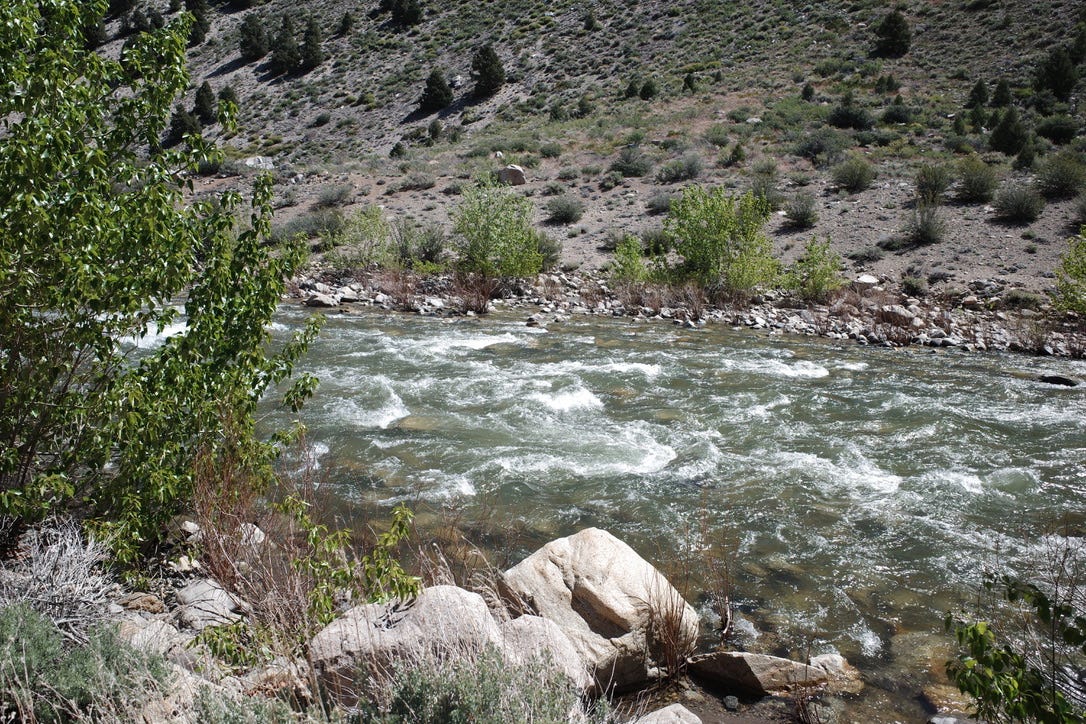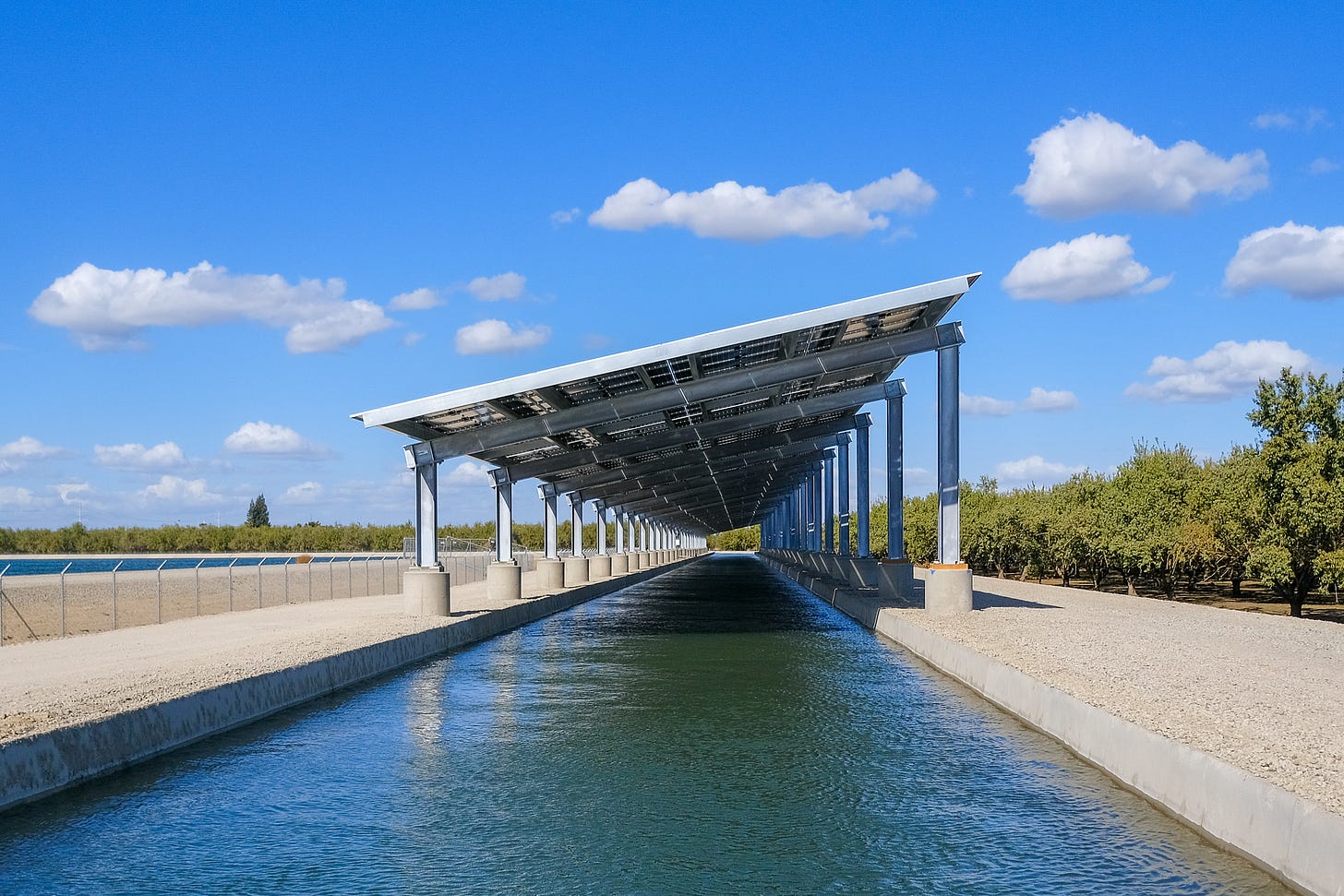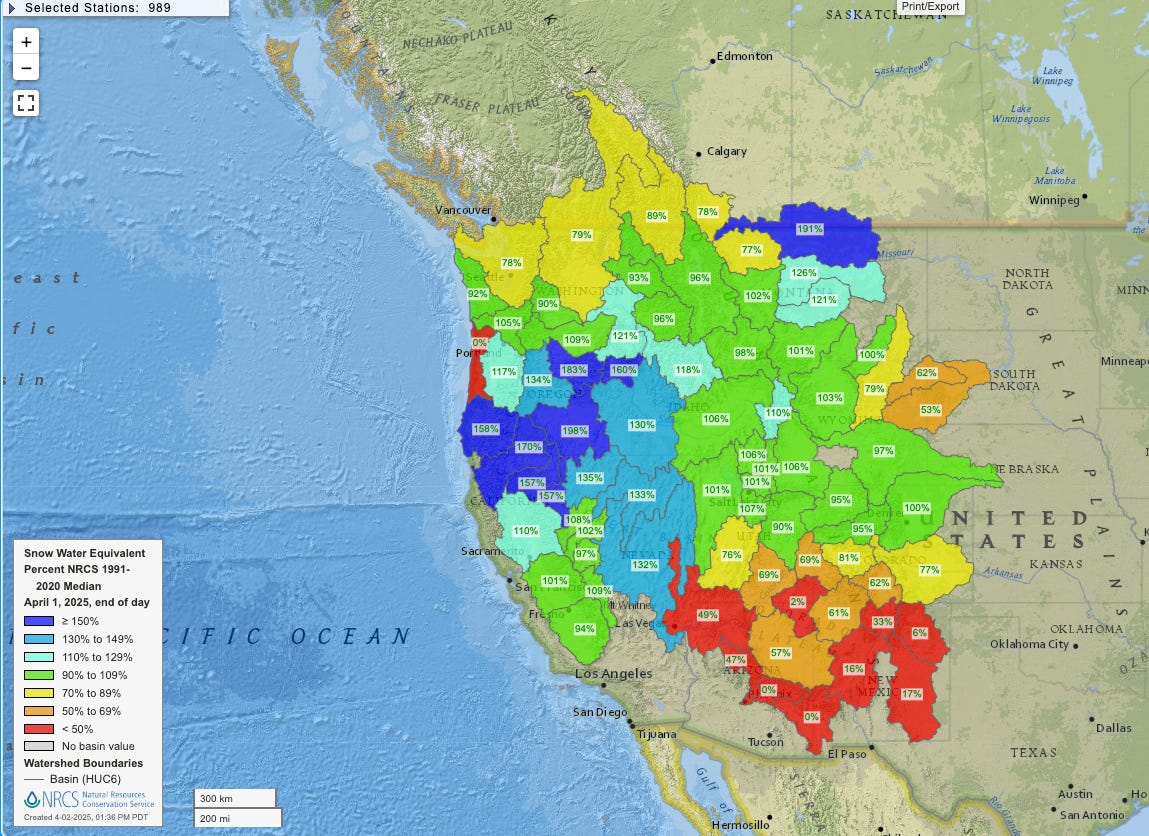Hello and back from a short hiatus.
Wanted to start out with a little offering I spotted on Bluesky. I can’t seem to find the original post, but the lines are credited to William Stafford, an Oregon poet who spent much time at Lake Oswego. These are his words, engraved on stone near the lake:
Water is always ready to learn.
The river always finds the right way.
I found the lines to resonate quite a bit, especially at a moment in history where so much of our concentration seems constantly tugged away from what is there in front of us. It resonated with me as a writer and journalist too. Sometimes you do not know where your writing is going, but with curiosity, you can find the right way. Or perhaps more appropriately, a right way, as there are many ways for rivers and words to flow.
On with the newsletter! Here are a couple of notes to start the month of April:
Lining canals with solar
A consortium of research universities are exploring ways to accelerate a promising solution to conserve water—and generate renewable electricity all at the same time.
The idea of putting solar panels above canals (or even reservoirs) is not new, but it’s gained a lot of momentum over the past few years as officials look for ways to better manage water and meet clean energy goals. As I wrote last year, once the investment is made, the benefits of siting solar panels above canals are multiple. You can…
Save water through reducing (often significant) evaporation loss from canals.
Generate renewable power on land that is permitted with existing rights-of-way.
Reduce vegetation/algae growth in canals, a considerable maintenance cost.
Build renewable energy in a low-conflict way by utilizing built environments.
At scale, covering canals with solar arrays could result in a not insignificant amount of water savings, and it’s something water managers are exploring more seriously (see pilot projects in the Gila River Indian Community and the Turlock Irrigation District).
A Nature Sustainability report in 2021 found that, in California, covering 4,000 miles of canals could save about 63 billion gallons of water. But despite the aggregate benefits of putting solar over canals, the barriers to bring individual projects online can be significant. They include physical constraints, time, technical expertise, and funding.
Enter the California Solar Canal Initiative announced last week. Working with state agencies, the group is focusing on ways to “fast-track the deployment of solar power across the state by identifying prime locations and potential community benefits.”
It’s definitely something worth watching. More coverage from PV Magazine.
An inside look at the Klamath dam removals
Grist dropped an excellent and deeply reported five-part series on what went into the historic decision to decommission dams on the Klamath River. The full report can be found here, and here’s a link to a spotlight about their reporting and some excerpts:
…last week, Grist’s Jake Bittle and Anita Hofschneider published a five-part, 14,000-word feature delving into the decades-long history of how it all happened. In their story, they describe the dam removal as “the result of an improbable campaign that spanned close to half a century, roped in thousands of people, and came within an inch of collapse several times. Interviews with dozens of people on all sides of the dam removal fight, some of whom have never spoken publicly about their roles, reveal a collaborative achievement with few clear parallels in contemporary activism.”
Over many months, Bittle and Hofschneider interviewed dozens of people — tribal leaders, activists, farmers, former members of Congress, and beyond — about the battle to remove the dams. “It’s hard to do a call on this topic that’s, like, less than two hours long,” Hofschneider said. They paired these in-depth interviews with archival newspaper research to piece together the story as it had unfolded across decades, in many cases rebuilding scenes from years ago.
‘Wildly uncharted territory’ on the Colorado River
The quote comes from a story from Aspen Journalism’s Heather Sackett about the continued legal uncertainty between the upper and lower Colorado River basins.
But the Colorado River is in uncharted territory in many more ways than one.
There are only a few weeks left for the states to come up with a consensus agreement before a federal deadline. Meanwhile, the federal government for the first time denied a voluntary Colorado River request to Mexico over Rio Grande delivery shortfalls on the Texas border. The Voice of San Diego has an comprehensive piece looking at this.
In other news, I recommend this Paris Review piece by the always sharp and observant Meg Bernhard on the annual Colorado River Water Users Association gathering.
The old water supplies can be the new supplies
The UCLA Institute for the Environment and Sustainability released a new report assessing wastewater recycling in the Colorado River Basin states. It concludes that California is trailing behind Nevada, which reuses about 85% of its wastewater, and Arizona, which reuses about half its wastewater. Other states are even further behind.
Check out the coverage from the L.A. Times’ Ian James:
If California and other states were to pursue targets of recycling 40% or 50% of their wastewater, the researchers said, that would go a long way toward addressing the river’s gap between supply and demand. If every state achieved even 30%, they calculated, that would generate more than 450,000 acre-feet of water annually — almost as much as the total annual usage of Los Angeles.
Looking at the snowpack data
If April 1 marks the typical peak of snowpack, how things look depends a lot on where you live. California, notably, celebrated a snowpack trifecta (three consecutive years of average snow) for the first time in 25 years. The Great Basin also had a major water year, with many areas far above average. But that story does not hold for many parts of the Southwest (see: Arizona, New Mexico, Southern Utah and Southern Colorado).
Of all the states, New Mexico had an especially dry winter.
New Mexico journalist Laura Paskus (subscribe to her newsletter if you have not already done so!) wrote more about what’s going on in her state and in the Rio Grande Basin. She doesn’t mince words: “What should this mean to New Mexicans? That New Mexico’s leaders, water managers, and water users need to get their shit together.”
Her newsletter also pointed me to this helpful report from CLIMAS, the Climate Assessment for the Southwest. It’s worth reading, and I’ll quote the same paragraph she did: “The forecast estimate for Upper Colorado River Basin is for 84% of normal streamflow; for the Rio Grande, the forecast is for 52% of normal streamflow.”
As you can see, the Drought Monitor (updated last week before the recent California storm) reflects the geographic divide in snowpack and precipitation this water year.
A few remaining tabs
A new research paper documents groundwater gains in Arizona, though though aquifers face pressure from Colorado River shortages and drought.
New Mexico moves toward a PFAS ban (Environmental Health News)
Utah is the first state to ban fluoride in public drinking water (Associated Press)
Kern County farmers in agree to California delta tunnel funding (SJV Water)
One of California’s largest reservoirs could expand (San Francisco Chronicle)
Q&A with the Walker Basin Conservancy (Public Policy Institute of California)
Feds look to fast-track lithium exploration in McDermitt Caldera (Oregonian)









Have any of the proponents endorsing solar panels over canals ever did maintenance support on canal systems?
I don’t think so. Sand and debris constantly blows into canals. Vegetation takes root in those canals. How do you remove these obstructions when you have overhead solar panels and their support infrastructure every twenty feet or so?
This idea as noble as it is, in the real world is impractical. Same principle applies to throwing solar panels on Lake Mead to suppress evaporation.
Solar panels on canals reminds me of a very cool start-up, Emergy. They put small scale turbines in irrigation canals.
Great newsletter! Thanks!